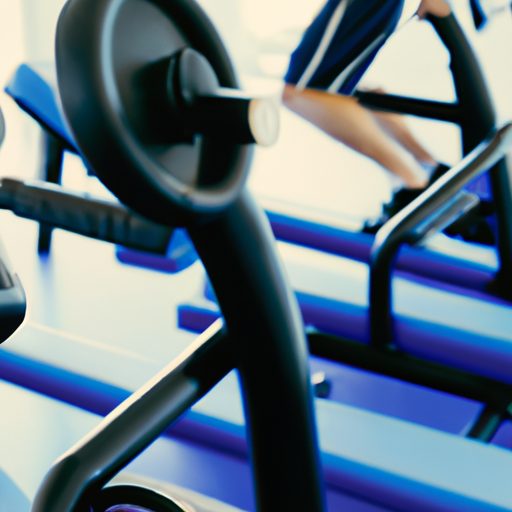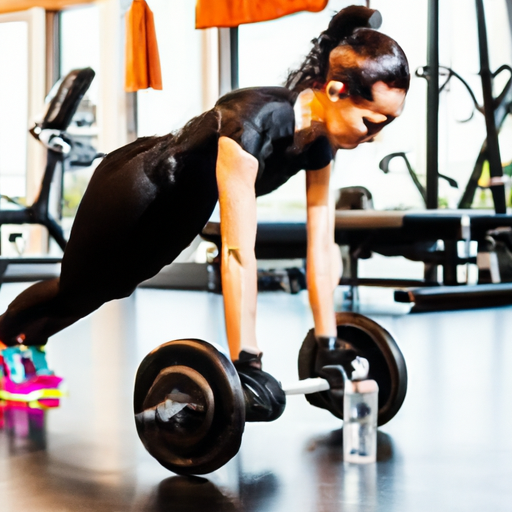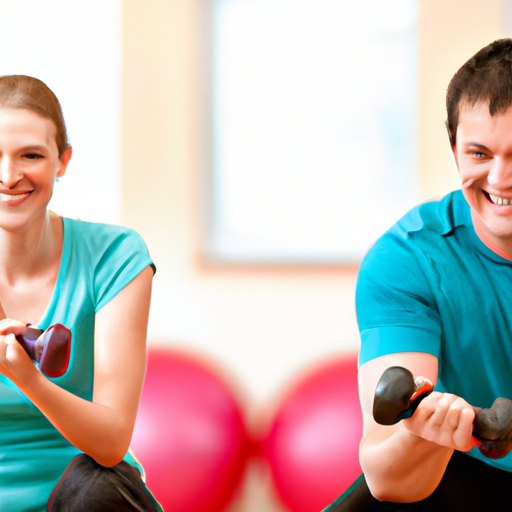When starting a fitness journey, it’s easy for beginners to feel overwhelmed by the countless exercise options and equipment available. However, fear not! This article will guide you through the world of fitness equipment and provide you with specific routines tailored for beginners. Whether you’re stepping into a gym for the first time or setting up your own home workout space, we’ve got you covered. Get ready to embark on a journey towards a healthier and stronger you!

Benefits of Using Equipment for Beginners
Increased resistance for strength training
Using equipment during your workouts can provide increased resistance, allowing you to effectively target and strengthen your muscles. For beginners, this can be especially beneficial as the added resistance helps to build strength and improve overall fitness levels. Whether you’re using dumbbells, resistance bands, or weight machines, incorporating equipment into your workouts can make a significant difference in your strength training routine.
Additional support and stability
One of the key benefits of using equipment as a beginner is the added support and stability it provides. For example, when performing exercises such as squats or lunges, using a kettlebell or dumbbells can help you maintain proper form and balance. This reduces your risk of injury and allows you to focus on targeting specific muscle groups effectively. Equipment such as exercise balls also offer stability and support for core exercises, making them ideal for beginners.
Versatility for a variety of exercises
Another advantage of using equipment is the versatility it offers in terms of exercise options. Dumbbells, resistance bands, exercise balls, kettlebells, and weight machines can be used for a wide range of exercises, making them suitable for beginners who are looking to work different muscle groups. This variety not only keeps your workouts interesting but also allows you to target specific areas of your body that you wish to develop or tone.
Choosing the Right Equipment for Beginners
Consider the space available
When selecting equipment for beginners, it’s important to consider the space you have available for your workouts. If you have limited space, opting for smaller equipment such as resistance bands or dumbbells would be more practical. On the other hand, if you have ample space, you can consider investing in larger equipment like weight machines or exercise balls. Make sure to choose equipment that fits well within your workout area and allows for comfortable movement.
Start with basic equipment
As a beginner, it’s best to start with basic equipment that is easy to use and does not require a steep learning curve. Dumbbells are a great starting point as they can be used for a wide range of exercises and usually come in different weight options. Resistance bands are also beginner-friendly, providing adjustable resistance and the ability to target various muscle groups. Starting with basic equipment allows you to focus on mastering the proper form and technique before progressing to more advanced equipment.
Consult with a trainer or expert
If you’re unsure about which equipment would be most suitable for you as a beginner, it’s a good idea to consult with a trainer or fitness expert. They can assess your current fitness level, goals, and any specific limitations or considerations you may have. A professional opinion can help you make an informed decision regarding the equipment that would best support your needs and help you achieve your fitness goals in a safe and effective manner.

Common Equipment for Beginners
Dumbbells
Dumbbells are versatile and easy to use, making them an excellent choice for beginners. They come in various weights, allowing you to gradually increase the resistance as you progress in your strength training journey. Dumbbells can be used for exercises targeting multiple muscle groups, including the arms, shoulders, chest, and legs.
Resistance bands
Resistance bands are a fantastic option for beginners as they provide adjustable resistance and can be used to target various muscle groups. They are lightweight, portable, and inexpensive, making them accessible for anyone looking to incorporate equipment into their workouts. Resistance bands can be used for exercises that focus on the arms, back, legs, and core, making them a versatile choice for beginners.
Exercise balls
Exercise balls, also known as stability balls or Swiss balls, are large inflatable balls that offer stability and support during exercises. They are particularly beneficial for core strengthening exercises and can help improve balance and stability. Exercise balls can also be used to target the arms, glutes, and legs, making them a versatile addition to a beginner’s workout routine.
Kettlebells
Kettlebells are weighted balls with a handle, providing a unique and challenging way to build strength and increase cardiovascular endurance. They are ideal for full-body workouts and can be used for exercises such as swings, squats, and lunges. While kettlebells may require some practice to master proper form, they offer a dynamic and effective workout option for beginners.
Weight machines
Weight machines are commonly found in gyms and provide guided movements that help beginners maintain proper form and reduce the risk of injury. They typically target specific muscle groups and allow for easy weight adjustments. Weight machines can be especially beneficial for beginners who may need additional support and stability during their workouts.
Full Body Workouts for Beginners
Warm-up exercises
Before starting any workout, it’s important to properly warm up your body to prevent injuries and prepare your muscles for the upcoming physical activity. A warm-up routine can include movements such as jogging in place, arm circles, leg swings, and light stretching exercises. Aim to warm up for at least 5-10 minutes before moving on to the main workout.
Cardiovascular exercises
Cardiovascular exercises elevate your heart rate, improve cardiovascular endurance, and burn calories. For beginners, options such as brisk walking, jogging, cycling, or using an elliptical machine can be effective. Aim for at least 20-30 minutes of cardio exercises during each full-body workout session.
Strength training exercises
Strength training exercises are essential for building muscle, improving overall strength, and increasing metabolism. As a beginner, you can start with bodyweight exercises such as squats, push-ups, lunges, and planks. As you progress, you can gradually incorporate equipment such as dumbbells, resistance bands, and weight machines to increase resistance and challenge your muscles.
Cooling down exercises
Cooling down is an important part of any workout routine as it allows your heart rate to gradually return to normal and helps prevent muscle soreness. Cooling down can involve exercises such as gentle stretching, yoga poses, or light aerobic movements. Aim to cool down for at least 5-10 minutes after completing your full-body workout.

Upper Body Workouts for Beginners
Chest exercises
To target the chest muscles, beginners can try exercises such as push-ups, chest presses with dumbbells or on a weight machine, and chest flies with dumbbells. These exercises help to strengthen and tone the chest muscles, contributing to improved upper body strength and posture.
Shoulder exercises
Shoulder exercises for beginners may include overhead presses with dumbbells, lateral raises with dumbbells, and shoulder rolls. These exercises help to strengthen the shoulder muscles and improve stability, which can be beneficial for daily activities and preventing shoulder injuries.
Back exercises
For beginners, back exercises can include exercises such as bent-over rows with dumbbells, seated cable rows, and back extensions. These exercises target the muscles of the upper and lower back, helping to improve posture, stability, and overall back strength.
Arm exercises
To work the muscles of the arms, beginners can try exercises such as bicep curls with dumbbells, tricep dips, and hammer curls. These exercises target the biceps, triceps, and forearm muscles, helping to improve arm strength and tone.
Lower Body Workouts for Beginners
Leg exercises
To target the leg muscles, beginners can perform exercises such as squats, lunges, and step-ups. These exercises engage major muscle groups like the quadriceps, hamstrings, and glutes. Starting with bodyweight exercises and gradually adding resistance with dumbbells or kettlebells can help to strengthen and tone the leg muscles.
Glute exercises
Strong glute muscles are essential for good posture, balance, and overall lower body strength. Beginners can incorporate exercises like glute bridges, hip thrusts, and donkey kicks into their workouts. These exercises specifically target the glute muscles, helping to strengthen and shape the buttocks.

Core Workouts for Beginners
Abdominal exercises
To target the abdominal muscles, beginners can try exercises such as crunches, planks, and Russian twists. These exercises engage the rectus abdominis, obliques, and transverse abdominis, helping to strengthen the core and improve stability.
Oblique exercises
Exercises that target the oblique muscles include side planks, bicycle crunches, and side bends with dumbbells. These exercises help to strengthen and define the muscles along the sides of the abdomen, contributing to a more toned and defined waistline.
Lower back exercises
To strengthen the muscles of the lower back, beginners can incorporate exercises such as supermans, bird dogs, and lower back extensions. These exercises help to improve back stability and posture, reducing the risk of lower back pain and injury.
Circuit Training for Beginners
Choosing exercises for a circuit
Circuit training involves performing a series of exercises back-to-back with minimal rest in between. To create a circuit training routine for beginners, choose exercises that target different muscle groups and can be performed with equipment such as dumbbells, resistance bands, or bodyweight exercises. Aim for a mix of cardio and strength exercises to create a well-rounded circuit routine.
Determining the duration and intensity
As a beginner, it’s important to start with a manageable duration and intensity level for your circuit training workouts. Begin with a circuit that lasts around 15-20 minutes, performing each exercise for a set amount of time or a specific number of repetitions. Start with lighter weights or lower resistance and gradually increase as your fitness level improves.
Rest periods in between circuits
Rest periods are an essential part of circuit training as they allow your body to recover and prepare for the next set of exercises. As a beginner, aim for short rest periods of around 30-60 seconds between each exercise or circuit. Adjust the rest periods based on your individual fitness level and make sure to listen to your body’s needs.
Creating a Beginner’s Routine with Equipment
Setting realistic goals
When creating a beginner’s routine with equipment, it’s important to set realistic goals that align with your current fitness level and long-term objectives. Start by identifying what you want to achieve, whether it’s building strength, improving flexibility, or losing weight. Break down your goals into manageable milestones and design your routine to gradually progress towards achieving them.
Balancing cardio and strength training
A well-rounded beginner’s routine should include a balance of both cardio and strength training exercises. Cardiovascular exercises help to improve endurance, burn calories, and strengthen your cardiovascular system. Strength training exercises help to build muscle, increase metabolism, and improve overall strength. Aim to include a mix of cardio and strength exercises in your routine, focusing on different muscle groups each day.
Progressing gradually
As a beginner, it’s important to progress gradually in your workouts to prevent injury and allow your body to adapt to the demands of exercise. Start with lighter weights or lower resistance and gradually increase the intensity as your muscles become stronger and more accustomed to the exercises. Incorporate progressive overload principles such as increasing weight, repetitions, or sets over time to continuously challenge your body.
Incorporating rest days
Rest days are crucial for beginners as they allow your body to recover and repair between workouts. Aim for at least one or two rest days per week, during which you can engage in light stretching, yoga, or low-impact activities. Utilize these rest days to rejuvenate your body and reduce the risk of overtraining or burnout.
Safety Tips for Beginners Using Equipment
Learning proper form and technique
When using equipment as a beginner, it’s essential to learn and practice proper form and technique for each exercise. Poor form can lead to injuries and prevent you from effectively targeting the intended muscle groups. Consult with a trainer or fitness expert to ensure you are using the equipment correctly and performing exercises with proper alignment.
Starting with lighter weights or resistance
As a beginner, it’s important to start with lighter weights or lower resistance to allow your body to adapt and build a strong foundation. Gradually increase the weight or resistance as you become more comfortable and your muscles become stronger. Using weights or resistance that are too heavy can increase the risk of injury and hinder your progress.
Avoiding overexertion
While it’s natural to push yourself during workouts, it’s important to listen to your body and avoid overexertion. Overtraining can lead to physical and mental fatigue, increased risk of injury, and hindered progress. Take breaks when needed, modify exercises if necessary, and be mindful of your physical limits. It’s better to start slow and gradually increase intensity than to push too hard and risk burnout or injury.
Listening to your body
Above all, it’s crucial to listen to your body when using equipment as a beginner. Pay attention to any pain, discomfort, or unusual sensations during exercises. If something doesn’t feel right, stop the exercise and consult with a professional if needed. Your body is unique, and it’s important to respect its limitations and work within your comfort zone.
Using equipment as a beginner can greatly enhance your workouts by increasing resistance for strength training, providing additional support and stability, and offering versatility for a variety of exercises. By choosing the right equipment, designing a well-rounded routine, and prioritizing safety, you can make the most of your equipment workouts as a beginner. Remember to start where you are, progress gradually, and listen to your body throughout the journey. Enjoy the process and have fun exploring the benefits and possibilities that equipment training can bring to your fitness journey!
